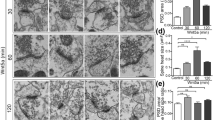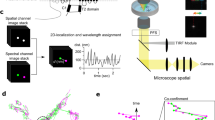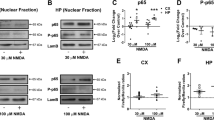Abstract
Here we report that synaptic and extrasynaptic NMDA (N-methyl-D-aspartate) receptors have opposite effects on CREB (cAMP response element binding protein) function, gene regulation and neuron survival. Calcium entry through synaptic NMDA receptors induced CREB activity and brain-derived neurotrophic factor (BDNF) gene expression as strongly as did stimulation of L-type calcium channels. In contrast, calcium entry through extrasynaptic NMDA receptors, triggered by bath glutamate exposure or hypoxic/ischemic conditions, activated a general and dominant CREB shut-off pathway that blocked induction of BDNF expression. Synaptic NMDA receptors have anti-apoptotic activity, whereas stimulation of extrasynaptic NMDA receptors caused loss of mitochondrial membrane potential (an early marker for glutamate-induced neuronal damage) and cell death. Specific blockade of extrasynaptic NMDA receptors may effectively prevent neuron loss following stroke and other neuropathological conditions associated with glutamate toxicity.
This is a preview of subscription content, access via your institution
Access options
Subscribe to this journal
Receive 12 print issues and online access
$209.00 per year
only $17.42 per issue
Buy this article
- Purchase on SpringerLink
- Instant access to full article PDF
Prices may be subject to local taxes which are calculated during checkout








Similar content being viewed by others
References
Carafoli, E., Santella, L., Branca, D. & Brini, M. Generation, control, and processing of cellular calcium signals. Crit. Rev. Biochem. Mol. Biol. 36, 107–260 (2001).
Berridge, M. J. Neuronal calcium signaling. Neuron 21, 13–26 (1998).
Milner, B., Squire, L. R. & Kandel, E. R. Cognitive neuroscience and the study of memory. Neuron 20, 445–468 (1998).
Bading, H., Ginty, D. D. & Greenberg, M. E. Regulation of gene expression in hippocampal neurons by distinct calcium signaling pathways. Science 260, 181–186 (1993).
Bito, H., Deisseroth, K. & Tsien, R. W. CREB phosphorylation and dephosphorylation: a Ca2+ and stimulus duration–dependent switch for hippocampal gene expression. Cell 87, 1203–1214 (1996).
Fields, R. D., Esthete, F., Stevens, B. & Itoh, K. Action potential–dependent regulation of gene expression: temporal specificity in calcium, cAMP-reponsive element binding proteins, and mitogen-activated protein kinase signalling. J. Neurosci. 17, 7252–7266 (1997).
Hardingham, G. E., Chawla, S., Johnson, C. M. & Bading, H. Distinct functions of nuclear and cytoplasmic calcium in the control of gene expression. Nature 385, 260–265 (1997).
Hardingham, G. E., Chawla, S., Cruzalegui, F. H. & Bading, H. Control of recruitment and transcription-activating function of CBP determines gene regulation by NMDA receptors and L-type calcium channels. Neuron 22, 789–798 (1999).
Hardingham, G. E., Arnold, F. J. L. & Bading, H. Nuclear calcium signaling controls CREB-mediated gene expression triggered by synaptic activity. Nat. Neurosci. 4, 261–267 (2001).
Chawla, S. & Bading, H. CREB/CBP and SRE-interacting transcriptional regulators are fast on–off switches: duration of calcium transients specifies the magnitude of transcriptional responses. J. Neurochem. 79, 849–858.
Hardingham, G. E., Arnold, F. J. L. & Bading, H. A calcium microdomain near NMDA receptors: on-switch for ERK-dependent synapse-to-nucleus communication. Nat. Neurosci. 4, 565–566 (2001).
Bading, H. Transcription-dependent neuronal plasticity: the nuclear calcium hypothesis. Eur. J. Biochem. 267, 5280–5283 (2000).
Ghosh, A., Carnahan, J. & Greenberg, M. E. Requirement for BDNF in activity-dependent survival of cortical neurons. Science 263, 1618–1623 (1994).
Deisseroth, K., Heist, E. K. & Tsien, R. W. Calmodulin translocation to the nucleus supports CREB phosphorylation in hippocampal neurons. Nature 392, 198–202 (1998).
Dolmetsch, R. E., Pajvani, U., Fife, K., Spotts, J. M. & Greenberg, M. E. Signaling to the nucleus by an L-type calcium channel–calmodulin complex through the MAP kinase pathway. Science 294, 333–339 (2001).
Bading, H. et al. N-methyl-d-aspartate receptors are critical for mediating the effects of glutamate on intracellular calcium concentration and immediate early gene expression in cultured hippocampal neurons. Neuroscience 64, 653–664 (1995).
Ginty, D. D. et al. Regulation of CREB phosphorylation in the suprachiasmatic nucleus by light and a circadian clock. Science 268, 238–241 (1993).
Lipsky, R. H., Xu, K., Zhu, D., Kelly, C., Terhakopian, A., Novelli, A. & Marini, A. M. Nuclear factor kappaB is a critical determinant in N-methyl-d-aspartate receptor–mediated neuroprotection. J. Neurochem. 78, 254–264 (2001).
Tao, X., Finkbeiner, S., Arnold, D. B., Shaywitz, A. J. & Greenberg, M. E. Ca2+ influx regulates BDNF transcription by a CREB family transcription factor–dependent mechanism. Neuron 20, 709–726 (1998).
Shieh, P. B., Hu, S.-C., Bobb, K., Timmusk, T. & Ghosh, A. Identification of a signaling pathway involved in calcium regulation of BDNF expression. Neuron 20, 727–740 (1998).
Tovar, K. R. & Westbrook, G. L. The incorporation of NMDA receptors with a distinct subunit composition at nascent hippocampal synapses in vitro. J. Neurosci. 19, 4180–4188 (1999).
Sala, C., Rudolph-Correia, S. & Sheng, M. Developmentally regulated NMDA receptor–dependent dephosphorylation of cAMP response element–binding protein (CREB) in hippocampal neurons. J. Neurosci. 20, 3529–3536 (2000).
Williams, K. Ifenprodil discriminates subtypes of the N-methyl-d-aspartate receptor: selectivity and mechanisms at recombinant heteromeric receptors. Mol. Pharmacol. 44, 851–859 (1993).
Rossi, D. J., Oshima, T. & Attwell, D. Glutamate release in severe brain ischaemia is mainly by reversed uptake. Nature 403, 316–321 (2000).
Stout, A. K., Raphael, H. M., Kanterewicz, B. I., Klann, E. & Reynolds, I. J. Glutamate-induced neuron death requires mitochondrial calcium uptake. Nat. Neurosci. 1, 366–373 (1998).
White, R. J. & Reynolds, I. J. Mitochondrial depolarization in glutamate-stimulated neurons: an early signal specific to excitotoxin exposure. J. Neurosci 16, 5688–5697 (1996).
Schinder, A. F., Olson, E. C., Spitzer, N. C. & Montal, M. Mitochondrial dysfunction is a primary event in glutamate neurotoxicity. J. Neurosci. 16, 6125–6133 (1996).
Vergun, O., Keelan, J., Khodorov, B. I. & Duchen, M. R. Glutamate-induced mitochondrial depolarisation and perturbation of calcium homeostasis in cultured rat hippocampal neurones. J. Physiol. 519, 451–466 (1999).
Fujikawa, D.G., Shinmei, S. S. & Cai, B. Kainic acid-induced seizures produce necrotic, not apoptotic, neurons with internucleosomal DNA cleavage: implications for programmed cell death mechanisms. Neuroscience 98, 41–53 (2000).
Tymianski, M., Charlton, M. P., Carlen, P. L. & Tator, C. H. Source specificity of early calcium neurotoxicity in cultures embryonic spinal neurons. J. Neurosci. 13, 2085–2104 (1993).
Sattler, R., Charlton, M. P., Hafner, M. & Tymianski, M. Distinct influx pathways, not calcium load, determine neuronal vulnerability to calcium neurotoxicity. J. Neurochem. 71, 2346–2364 (1998).
Chang, K. T. & Berg, D. K. Voltage-gated channels block nicotinic regulation of CREB phosphorylation and gene expression in neurons. Neuron 32, 855–865 (2001).
Hagiwara, M. et al. Transcriptional attenuation following cAMP induction requires PP-1-mediated dephosphorylation of CREB. Cell 70, 105–113 (1992).
Bollen, M. Combinatorial control of protein phosphatase-1. Trends Biochem. Sci. 26, 426–431 (2001).
Hu, S. C., Chrivia, J. & Ghosh, A. Regulation of CBP-mediated transcription by neuronal calcium signaling. Neuron 22, 799–808 (1999).
Husi, H., Ward, M. A., Choudhary, J. S., Blackstock, W. P. & Grant, S. G. N. Proteomic analysis of NMDA receptor–adhesion protein signaling complexes. Nat. Neurosci. 3, 661–669 (2000).
Parpura, V., Basarsky, T. A., Liu, F., Jeftinija, K., Jeftinija, S. & Haydon, P. G. Glutamate-mediated astrocyte–neuron signalling. Nature 369, 744–747 (1994).
Ikonomidou, C. et al. Blockade of NMDA receptors and apoptotic neurodegeneration in the developing brain. Science 283, 70–74 (1999).
Ikonomidou, C., Stefovska, V. & Turski, L. Neuronal death enhanced by N-methyl-d-aspartate antagonists. Proc. Natl. Acad. Sci. USA 97, 12885–12890 (2000).
Young, D., Lawlor, P. A., Leone, P., Dragunow, M. & During, M. J. Environmental enrichment inhibits spontaneous apoptosis, prevents seizures and is neuroprotective. Nat. Med. 5, 448–453 (1999).
Olney, J. W., Collins, R. C. & Sloviter, R. S. Excitotoxic mechanisms of epileptic brain damage. Adv. Neurol. 44, 857–77 (1986).
Bittigau, P. & Ikonomidou, C. Glutamate in neurologic diseases. J. Child Neurol. 12, 471–485 (1997).
Dirnagl, U., Iadecola, C. & Moskowitz, M. A. Pathobiology of ischaemic stroke: an integrated view. Trends Neurosci. 22, 391–397 (1999).
Lee, J.-M., Zipfel, G. J. & Choi, D. W. The changing landscape of ischaemic brain injury mechanisms. Nature 399, A7–A14 (1999).
Hossmann, K. A. Viability thresholds and the penumbra of focal ischemia. Ann. Neurol. 36, 557–565 (1994).
Riccio, A., Ahn, S., Davenport, C. M., Blendy, J. A. & Ginty, D. D. Mediation by a CREB family transcription factor of NGF-dependent survival of sympathetic neurons. Science 286, 2358–2361 (1999).
Walton, M. R. & Dragunow, M. Is CREB a key to neuronal survival? Trends Neurosci. 23, 48–53 (2000).
Kokaia, Z. et al. Regulation of brain-derived neurotrophic factor gene-expression after transient middle cerebral artery occlusion with and without brain damage. Exp. Neurol. 136, 73–88 (1995).
Bading, H. & Greenberg, M. E. Stimulation of protein tyrosine phosphorylation by NMDA receptor activation. Science 253, 912–914 (1991).
Keelan, J., Vergun, O. & Duchen, M. R. Excitotoxic mitochondrial depolarisation requires both calcium and nitric oxide in rat hippocampal neurons. J. Physiol. 520, 797–813 (1999).
Acknowledgements
We thank F. Arnold for help with the multi-electrode array recordings, and P. Vanhoutte and B. Wisden for discussion. This work was supported by the Medical Research Council, Clare College, Cambridge, and the Alexander von Humboldt Foundation.
Author information
Authors and Affiliations
Corresponding author
Ethics declarations
Competing interests
The authors declare no competing financial interests.
Rights and permissions
About this article
Cite this article
Hardingham, G., Fukunaga, Y. & Bading, H. Extrasynaptic NMDARs oppose synaptic NMDARs by triggering CREB shut-off and cell death pathways. Nat Neurosci 5, 405–414 (2002). https://doi.org/10.1038/nn835
Received:
Accepted:
Published:
Issue Date:
DOI: https://doi.org/10.1038/nn835



